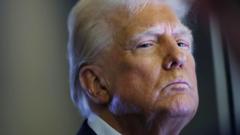As night fell on Saturday, Air Force One soared from Las Vegas to Miami, marking the beginning of Donald Trump's second era in the Oval Office. The atmosphere inside was set for a confident leader: Fox News blared on the in-flight screens, as Trump prepared to engage with reporters who had gathered at the back of the plane, eager to learn about the president's renewed vision for America.
Fresh from a tumultuous week that saw drastic changes to immigration policy and the government structure, Trump couldn’t hide his satisfaction. “We’re getting A-pluses for the work done and the volume of it," he proclaimed. His self-assured demeanor indicated a distinct difference from the quieter press engagements of his predecessor, Joe Biden.
Trump's return came with a noticeable shift in executive decorum, reinstating the Diet Coke button and adorning the Oval Office with icons of past administrations, including a bust of Winston Churchill. But beyond these symbolic gestures lies a massive overhaul of policies that has swiftly unfolded in just six days.
Significantly, Trump’s administration has taken decisive action to erase Biden’s legacy almost entirely, issuing a series of executive orders that mark a stark departure in the political landscape. The president has not only pardoned many of his supporters involved in the Capitol riot but has also taken bold stances, such as renaming the Gulf of Mexico the Gulf of America and withdrawing the US from international agreements.
This episodic narrative of an emboldened Trump suggests a man no longer navigating Washington as an outsider. Backed by a statement victory in the recent election, he has strategically capitalized on a Congress that leans favorably towards him, setting a course that aims to reshape America’s identity.
The tone in Trump's advisory circle has also notably shifted, with a team that comprises steadfast supporters and newer recruits, all united in their mission. Unlike the fumbling entries of 2017, this administration appears armed with thorough strategies and a clear understanding of how to implement significant changes.
With 26 executive orders signed on his first day alone—quadrupling Biden’s inaugural efforts—Trump's trajectory is firmly set. The bold directives are indicative of a strategy to reclaim his narrative and diminish opposition. Political historian Douglas Brinkley likens Trump's actions to those of Franklin D. Roosevelt, who sought to redefine the honors accorded to previous leaders.
Trump's challenges are monumental, facing a landscape marred by division, but if the initial week is any indication, he seems undeterred in his mission to leave a legacy that resonates through history.
Fresh from a tumultuous week that saw drastic changes to immigration policy and the government structure, Trump couldn’t hide his satisfaction. “We’re getting A-pluses for the work done and the volume of it," he proclaimed. His self-assured demeanor indicated a distinct difference from the quieter press engagements of his predecessor, Joe Biden.
Trump's return came with a noticeable shift in executive decorum, reinstating the Diet Coke button and adorning the Oval Office with icons of past administrations, including a bust of Winston Churchill. But beyond these symbolic gestures lies a massive overhaul of policies that has swiftly unfolded in just six days.
Significantly, Trump’s administration has taken decisive action to erase Biden’s legacy almost entirely, issuing a series of executive orders that mark a stark departure in the political landscape. The president has not only pardoned many of his supporters involved in the Capitol riot but has also taken bold stances, such as renaming the Gulf of Mexico the Gulf of America and withdrawing the US from international agreements.
This episodic narrative of an emboldened Trump suggests a man no longer navigating Washington as an outsider. Backed by a statement victory in the recent election, he has strategically capitalized on a Congress that leans favorably towards him, setting a course that aims to reshape America’s identity.
The tone in Trump's advisory circle has also notably shifted, with a team that comprises steadfast supporters and newer recruits, all united in their mission. Unlike the fumbling entries of 2017, this administration appears armed with thorough strategies and a clear understanding of how to implement significant changes.
With 26 executive orders signed on his first day alone—quadrupling Biden’s inaugural efforts—Trump's trajectory is firmly set. The bold directives are indicative of a strategy to reclaim his narrative and diminish opposition. Political historian Douglas Brinkley likens Trump's actions to those of Franklin D. Roosevelt, who sought to redefine the honors accorded to previous leaders.
Trump's challenges are monumental, facing a landscape marred by division, but if the initial week is any indication, he seems undeterred in his mission to leave a legacy that resonates through history.




















